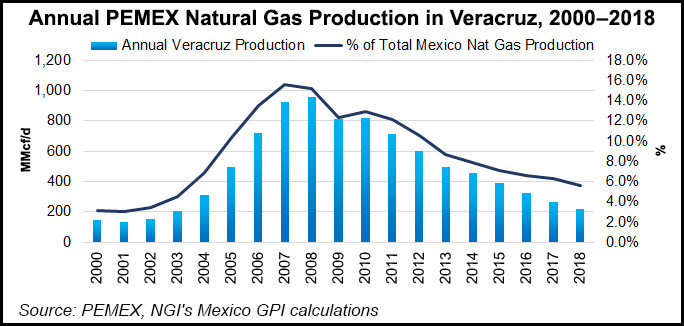NGI The Weekly Gas Market Report | E&P | NGI All News Access
Pemex Bets on Natural Gas-Rich Ixachi Field; AMLO Backs Production Goals
Mexico’s state oil company Petróleos Mexicanos (Pemex) will invest 56 billion pesos or about $3 billion in the natural gas-rich Ixachi field in Veracruz with the aim of reaching production of 80,000 b/d of crude and 600 MMcf/d of gas by 2023, CEO Octavio Romero Oropeza said on Tuesday.

The field, considered one of the biggest finds in the past two decades in Mexico with proved, possible and probable reserves of 1.5 billion boe, is already producing 30 MMcf/d of gas and 3,600 b/d of condensate, Romero said.
Though important to improving gas supply to Mexico’s gas-deprived southeast, Ixachi would only partially offset gas declines in the country. Pemex gas production fell to an average 3.66 Bcf/d in the first quarter compared to 3.886 Bcf/d in 2018, 4.205 Bcf/d in 2017 and 4.866 Bcf/d in 2016. Production peaked at 6.516 Bcf/d in 2009.
However, Ixachi is only a part — albeit the biggest part — of the plan to reverse declining production.
At the Tuesday event announcing Pemex’s exploration and production (E&P) plans at the Ixachi field in Tierra Blanca in Veracruz state, President Andrés Manuel López Obrador said the company would develop 20-40 fields for each year of his six-year presidency and would “exceed” its production goals. These goals have been previously put at 2.4 million b/d of oil and about 5.6 Bcf/d of gas by 2024.
“We are going to recover our production,” he said. “In six months we have already signed all the contracts for the creation of infrastructure, exploration and the drilling of wells in 20 different fields. Those who know about this industry…they should be surprised that in such a short period of time we’ve been able to sign these contracts.
“If Ixachi is going to produce 80,000 b/d and we have 20 Ixachi-type fields starting this year, we will have new production of 1.6 million b/d by 2022. This is what makes us optimistic.”
Pemex’s E&P plans focus on shallow water and onshore conventional fields in the southeast, as well as onshore conventional fields in northern Mexico. However, they do not include deepwater or unconventional plays.
The president also outlined that among other initiatives, Pemex’s tax burden would be lowered for three years to fund its production drive. He said after that period, Pemex would again contribute to public finances in the final three years of his term, “as it did in the past, so that Pemex becomes the backboard of national development and oil is used for the future development of the nation.”
While criticizing the energy reform of 2013-14 for creating “lies” about production targets that were never met, the president said the 110 contracts awarded through bid rounds held during the previous administration would be honored.
“We are not going to cancel the contracts. What we want is that [private companies] invest and produce. They should be producing a lot more than the 200,000 b/d they said they will produce by 2024. And this will add to what Pemex will produce.
“There is a lot of potential there. There are cases where they’ve been given areas with proven oil resources and there are companies that are very astute and have hired professionals and directors from Pemex.”
Finally, the president said the fight against fuel theft was ongoing and had proven successful, with total theft down by 95% so far this year leading to potential savings for Pemex of 50 billion pesos in 2019, or $2.6 billion.
© 2024 Natural Gas Intelligence. All rights reserved.
ISSN © 2577-9877 | ISSN © 2577-9966 | ISSN © 1532-1266 |
